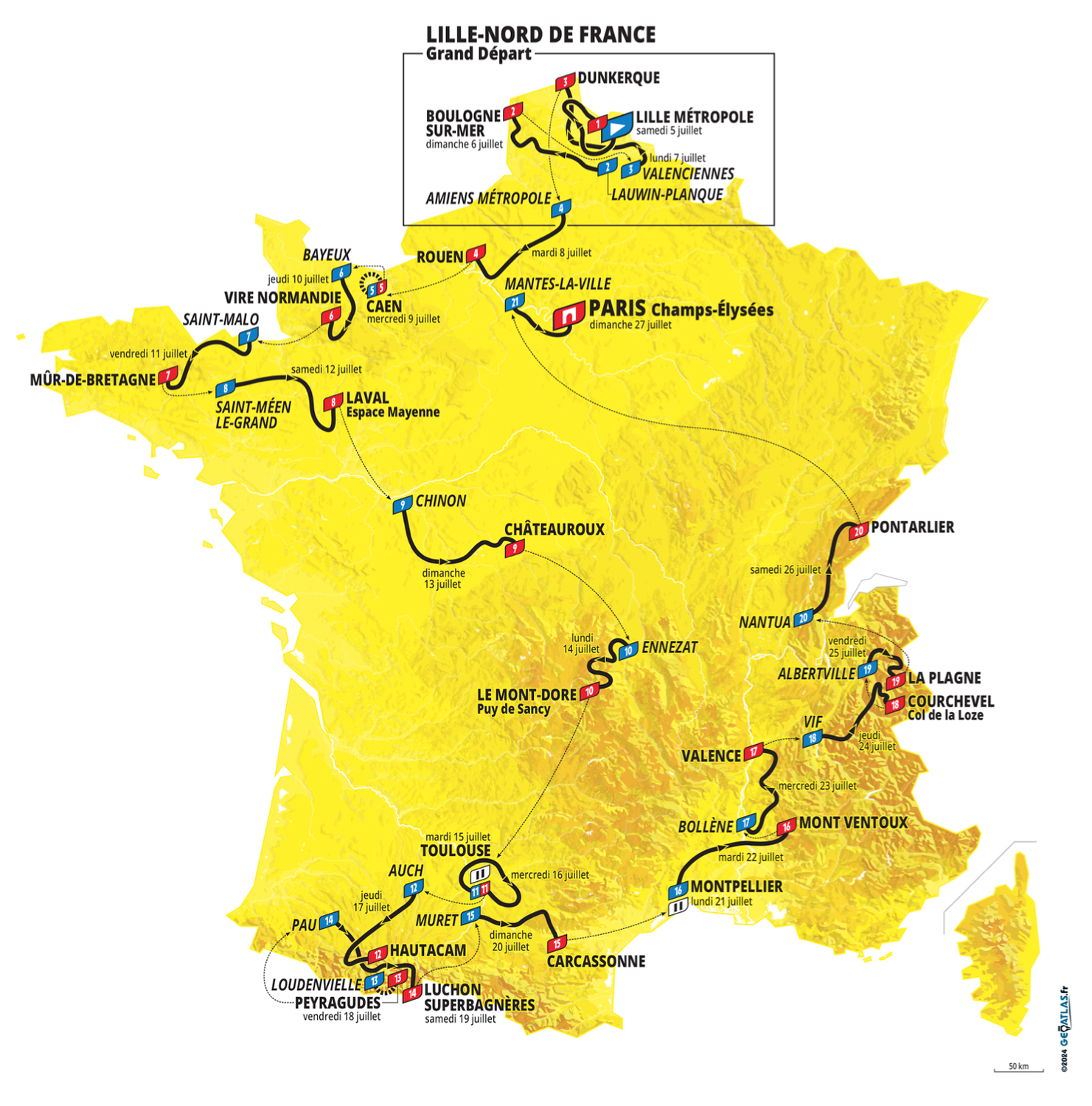
Here’s the 2025 Tour de France guide starting with the profiles of every stage with a quick summary of the day’s course.
There’s also the race rules like time bonuses, the points scale for the green and polka-dot jerseys, time cuts and more in case you need to look them up during July, just remember inrng.com/tour, …or bookmark it.
Route Summary
A busy opening week with some stages that will have the GC contenders in the mix. There are five big summit finishes, plus a mountain time trial spread across the second half of the race which look box office but the fear is each version offers a remake.
There are only five obvious sprint stages, several days feature small climbs which will foil some sprinters. There are time bonuses of 10-6-4 seconds at the finish line (nothing at the intermediate points and the “B” extra bonus sprints of old are gone too).
Stage 1 – Saturday 5 July
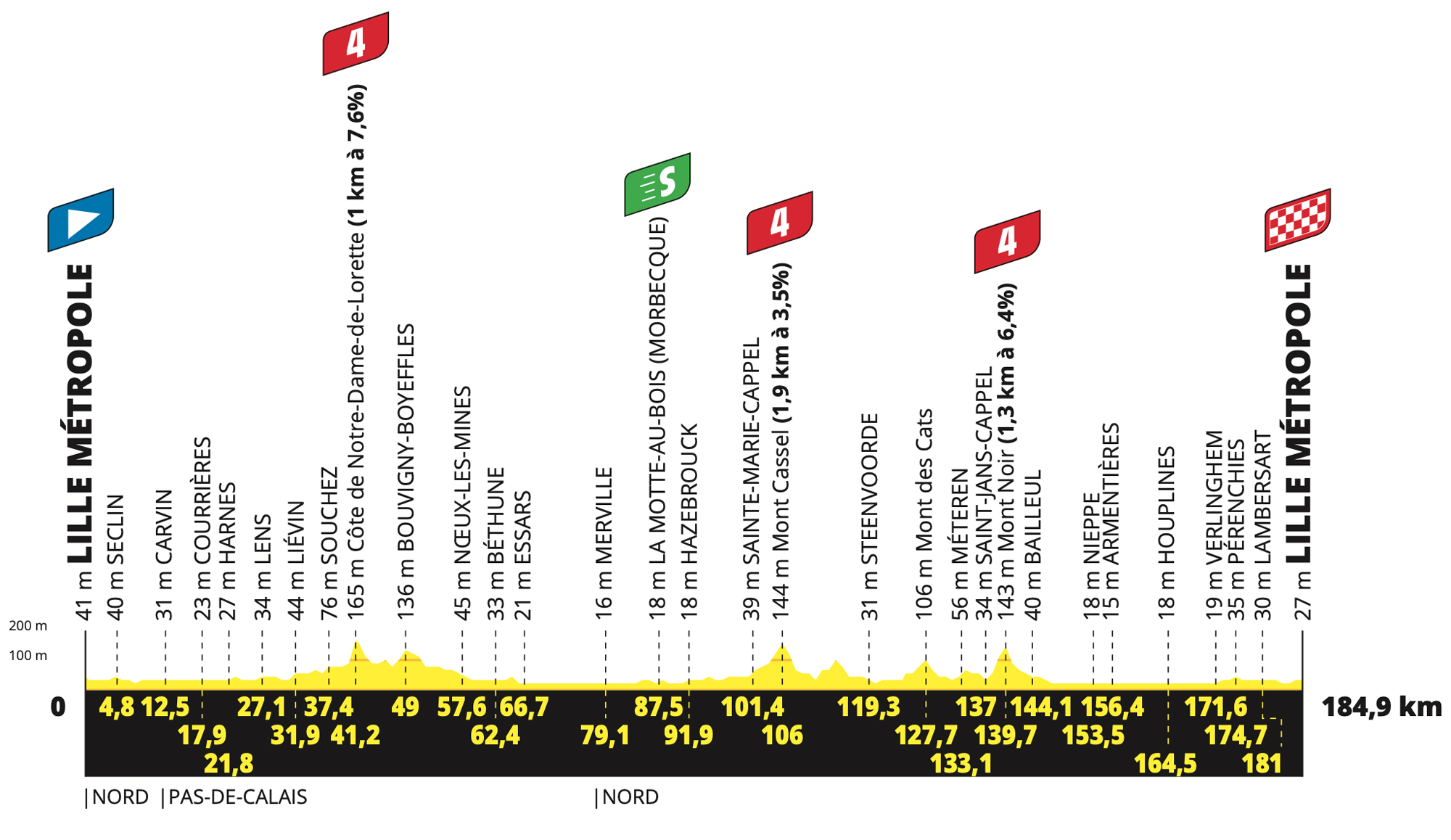
A chance for the sprinters to take the yellow jersey, their last chance was 2020. The Tour opener is often a nervous one and this course has its hazards in towns and villages. The first climb of the day to the Lorette war cemetery goes up a very narrow road. But the defining feature is the open roads and how they’re exposed if it’s windy, especially later on with Mont Cassel, the unclassified Mont des Cats and Mont Noir.
Stage 2 – Sunday 6 July
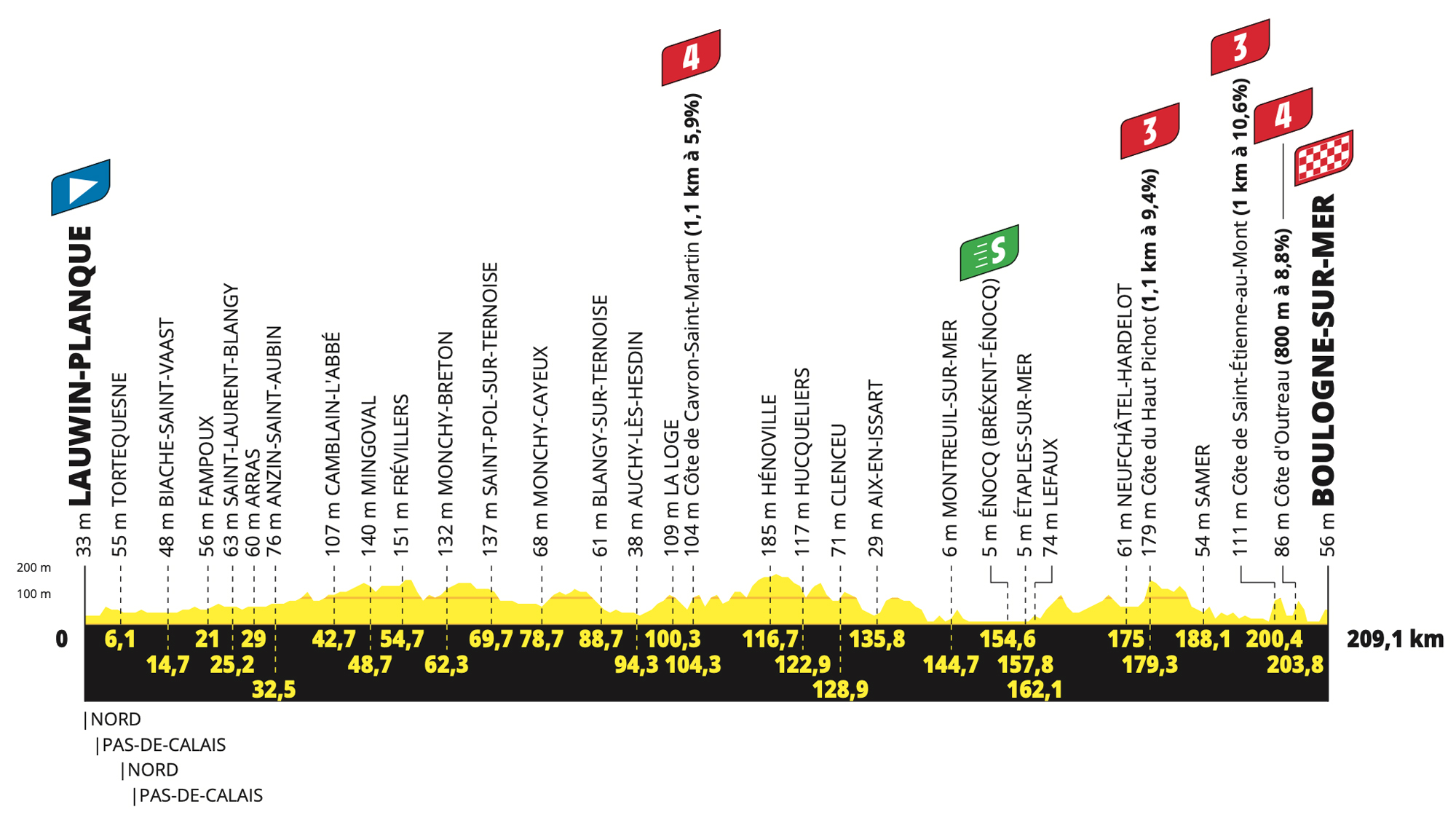
Flat at first glance , but over 2,000m of vertical gain and crucially some sharp climbs packed near the finish. The longest stage of the race, this one is not for the sprinters but those with more range.
Stage 3 – Monday 7 July
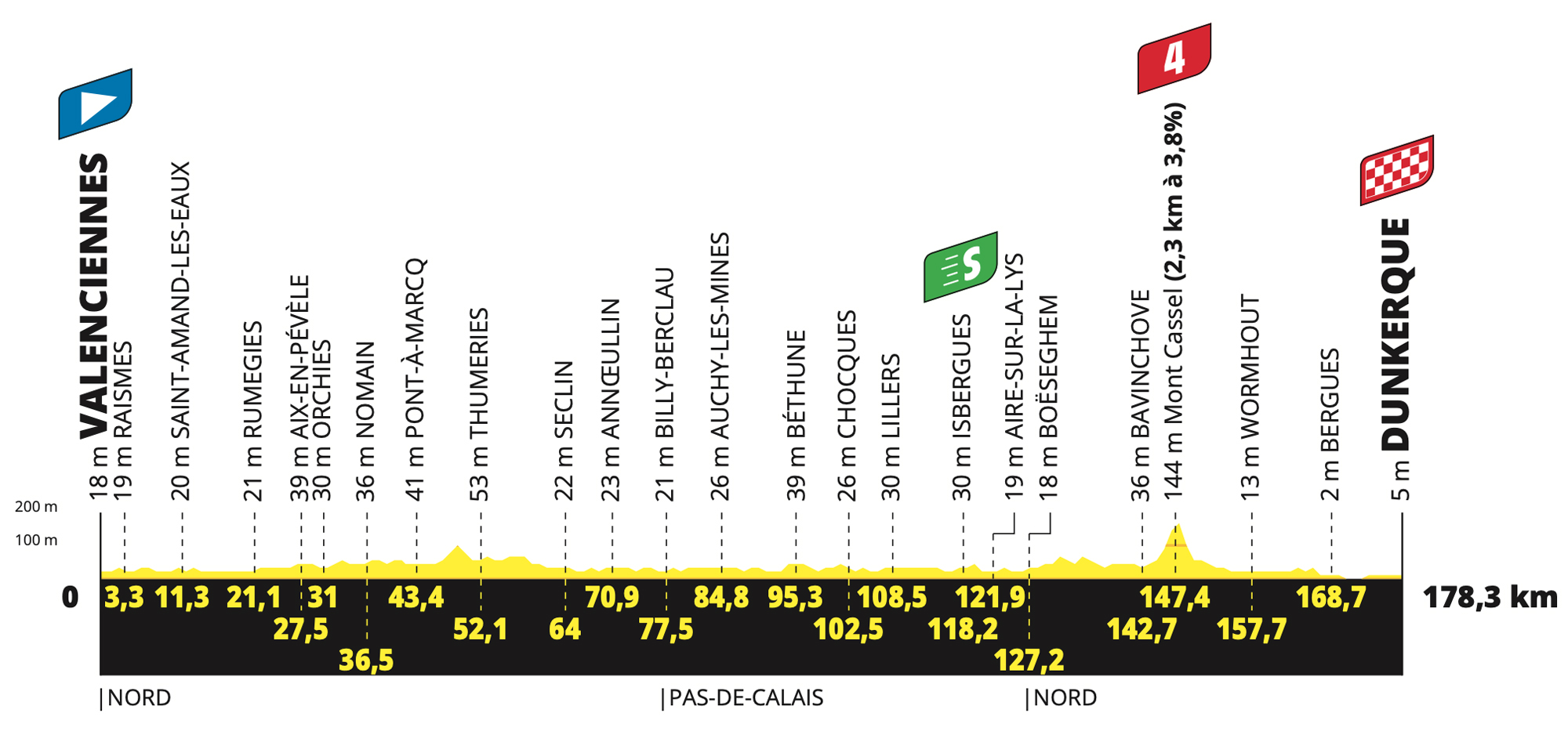
A day for the sprinters to take the yellow jersey. Mont Cassel is back and there are more exposed roads on the coast feature.
Stage 4 – Tuesday 8 July
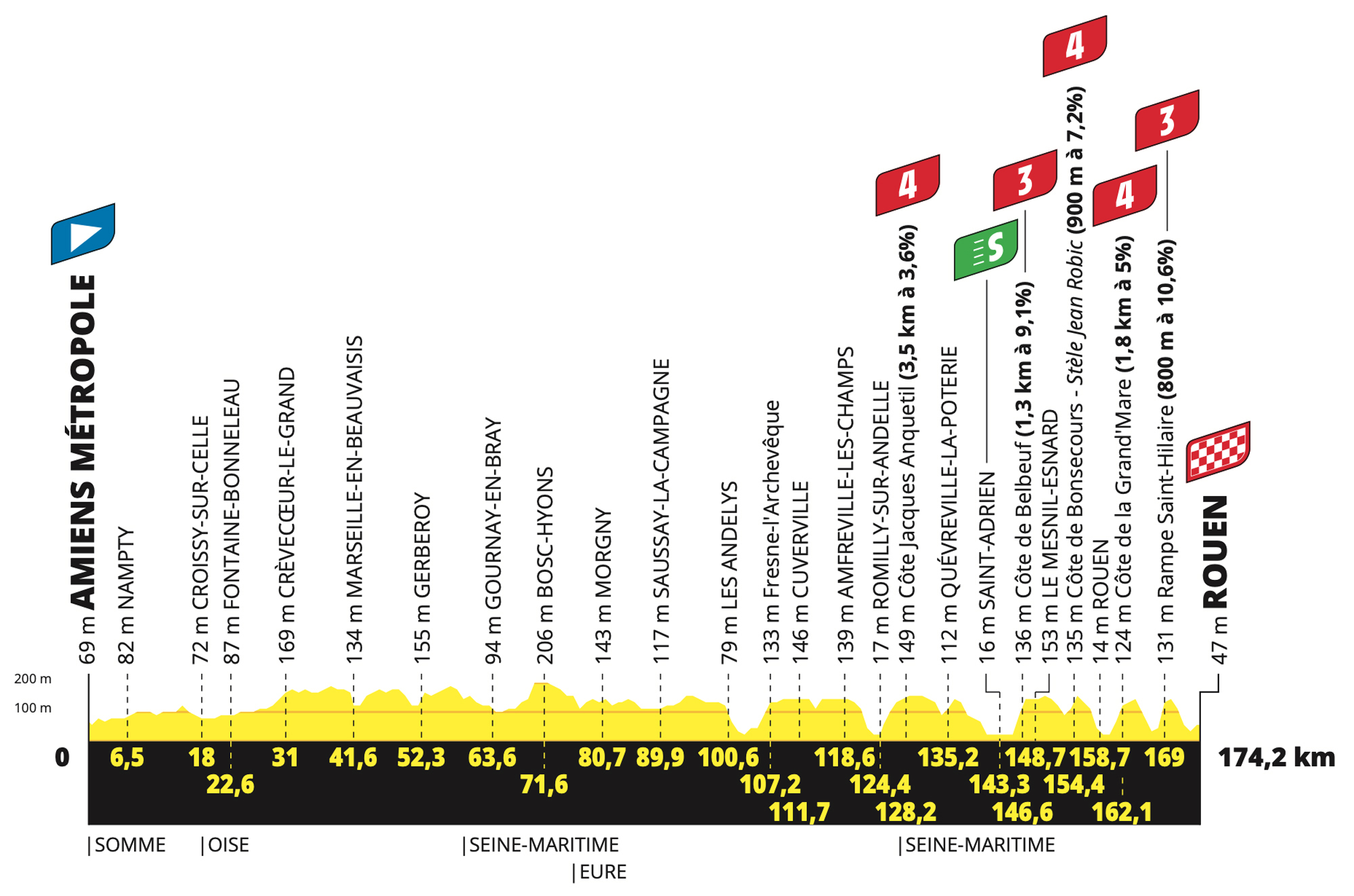
A tough stage with a dense finale packed with sharp climbs including an uphill finish. The stage is open to many kinds of riders and the GC contenders will be in the mix here as they can’t afford to be caught on the wrong side of a split.
Stage 5 – Wednesday 9 July

A 33km time trial. The course has few secrets, it’s not one where riders will be feathering the brakes and fanning the gear shifters, it’s a day for big chainrings.
Stage 6 – Thursday 10 July
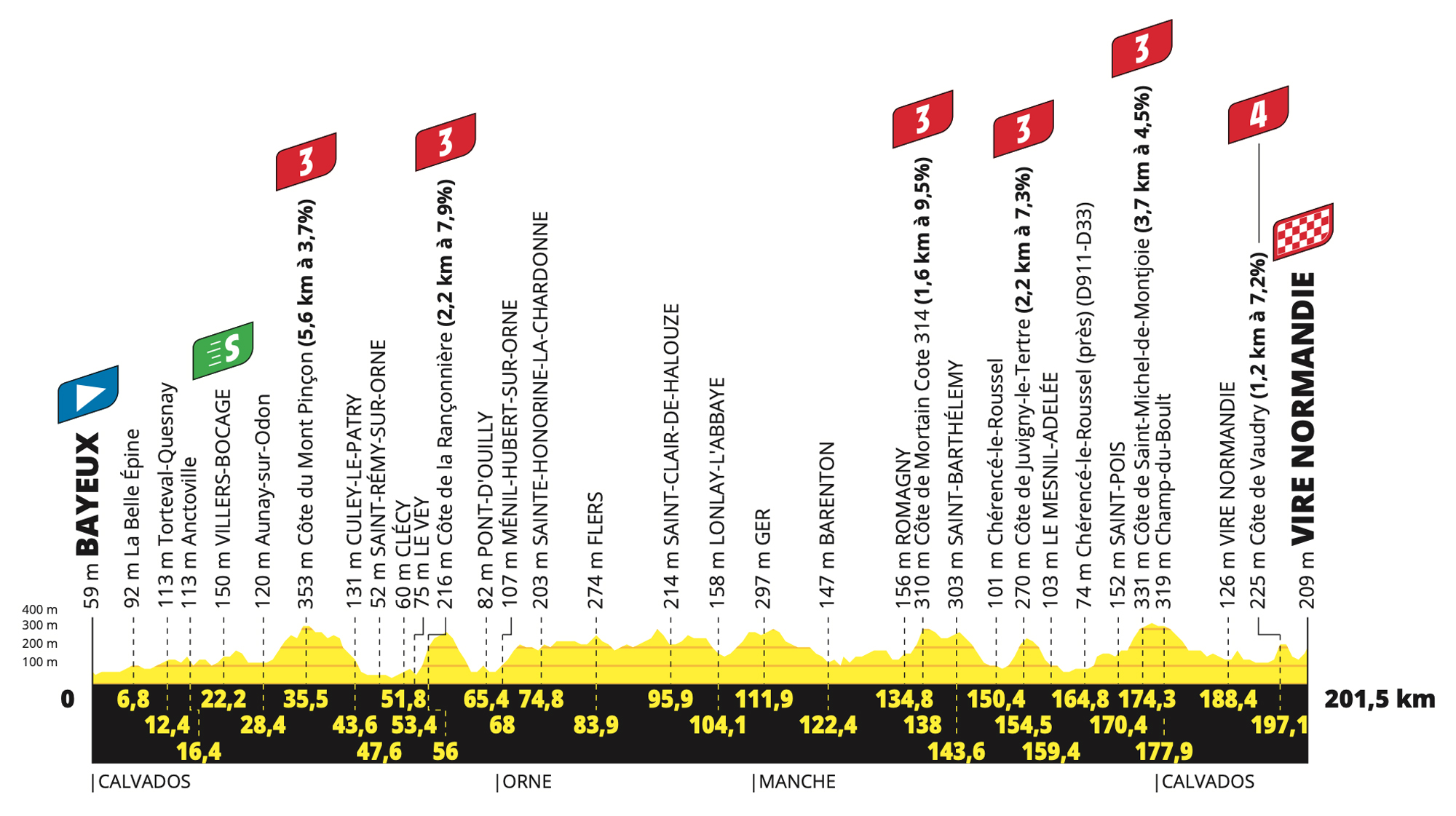
Looks flat and it’s in Normandy… but a tiring day with 3,550m of vertical gain thanks to a lot of climbs and an uphill finish with 10% for almost a kilometre.
Stage 7 – Friday 11 July
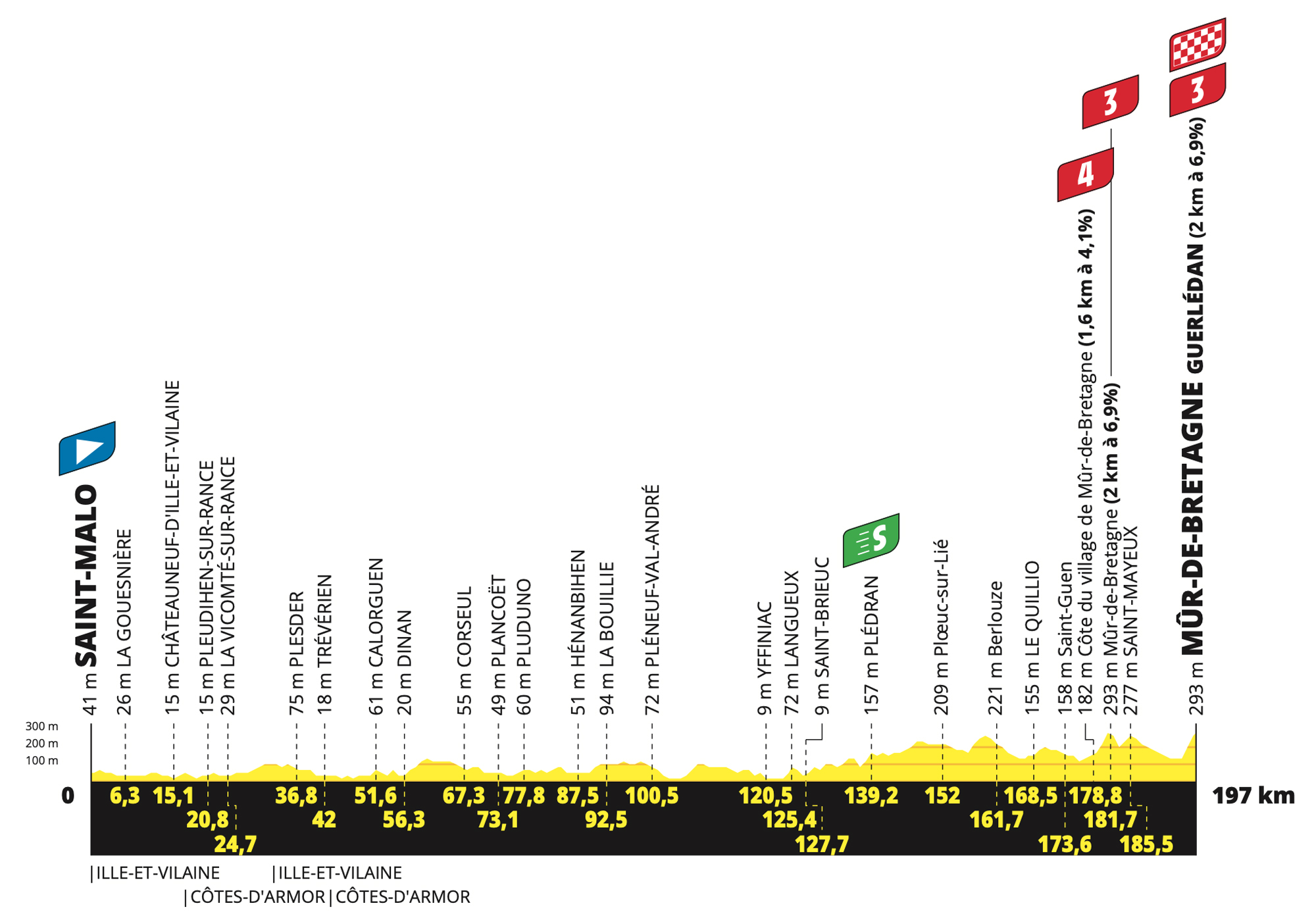
A stage in Brittany and the now habitual finish at Mûr-de-Bretagne which features because of the Tour’s in house dogma that sprint finishes can’t happen for more than two consecutive days and with the flat terrain coming up over the weekend this stage has to feature the climb twice.
Stage 8 – Saturday 12 July
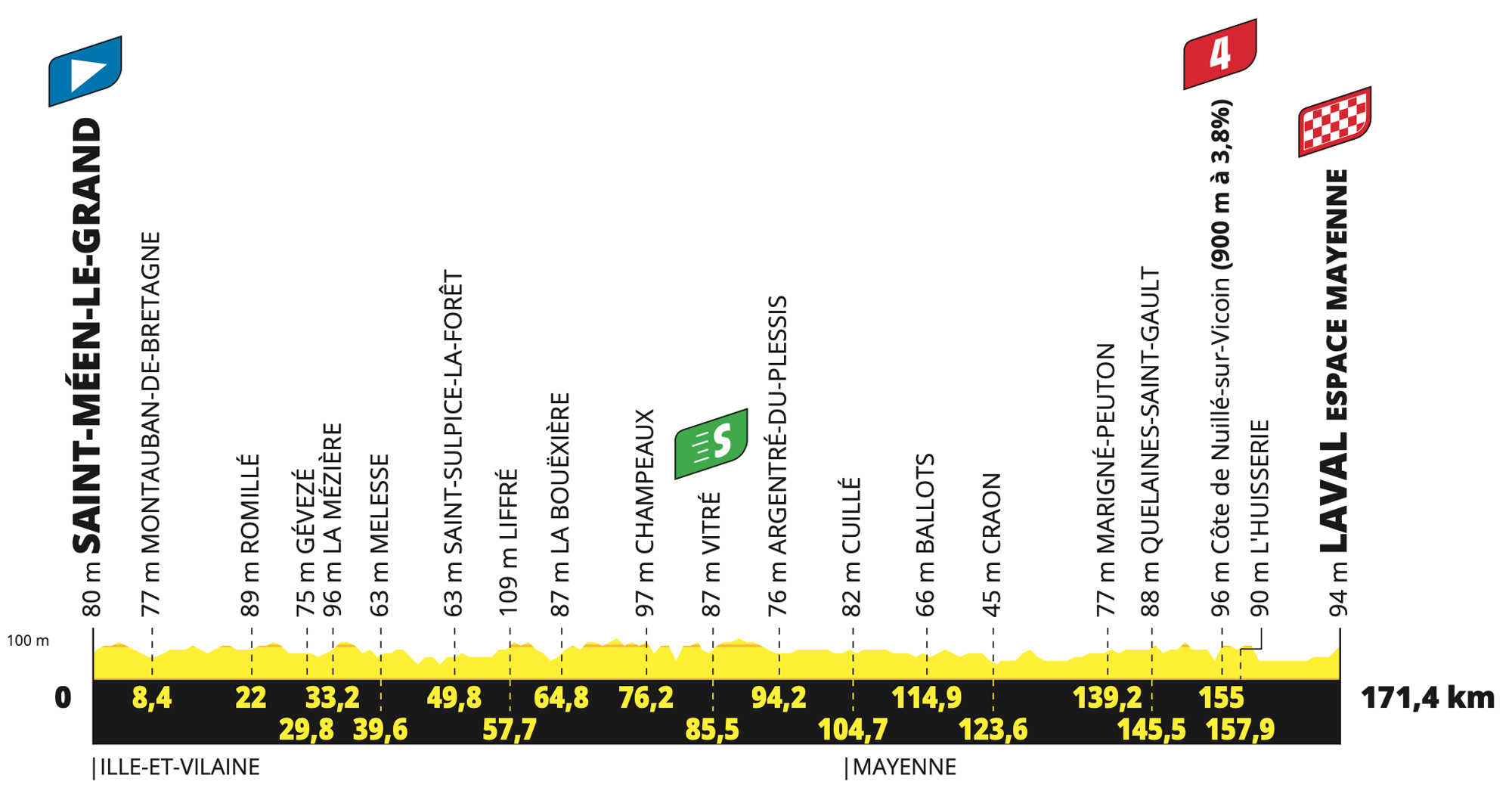
A sprint stage.
Stage 9 – Sunday 13 July
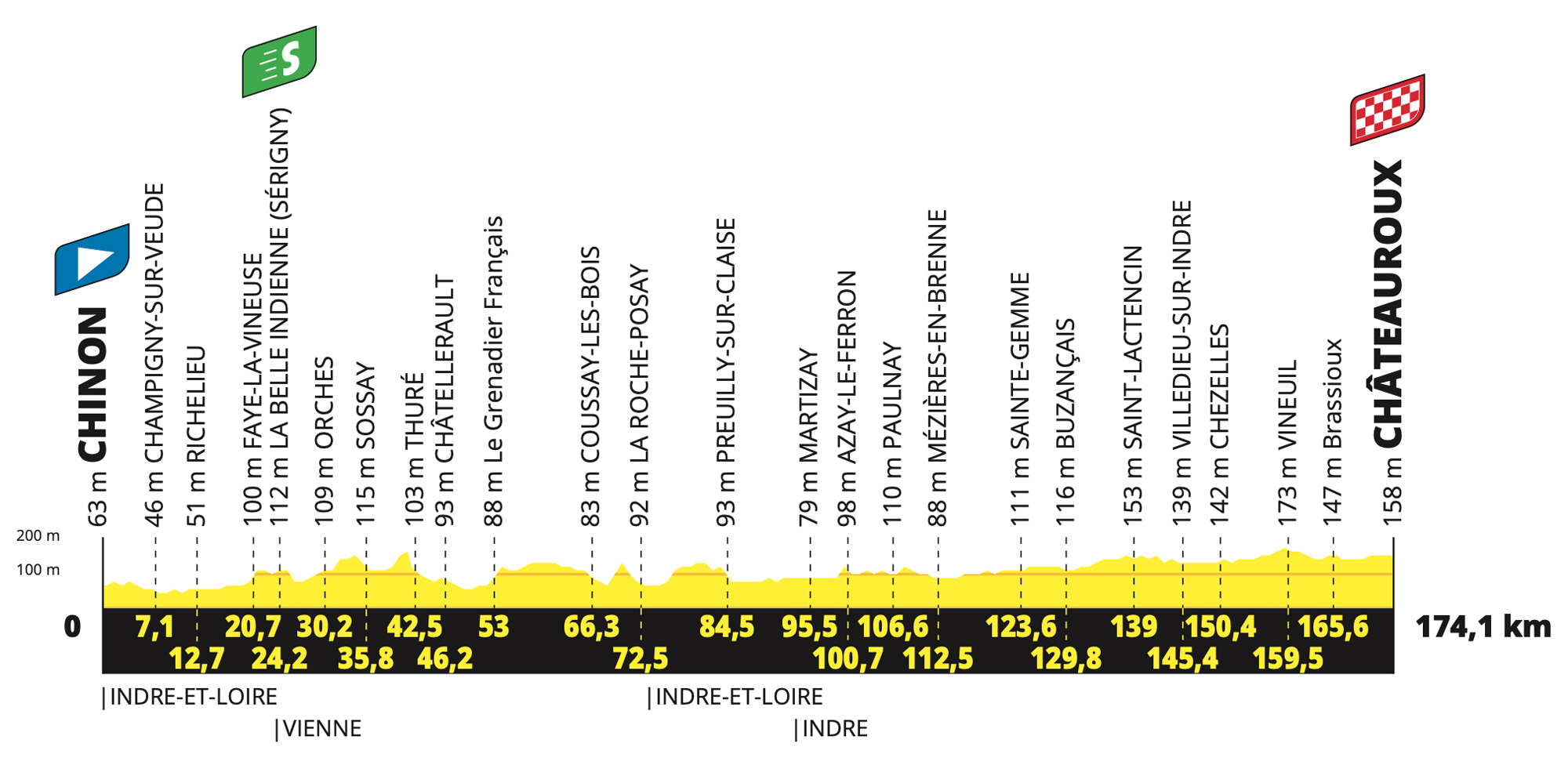
Another sprint stage. This makes for a sleepy weekend for TV spectators unless the wind is blowing.
Stage 10 – Monday 14 July
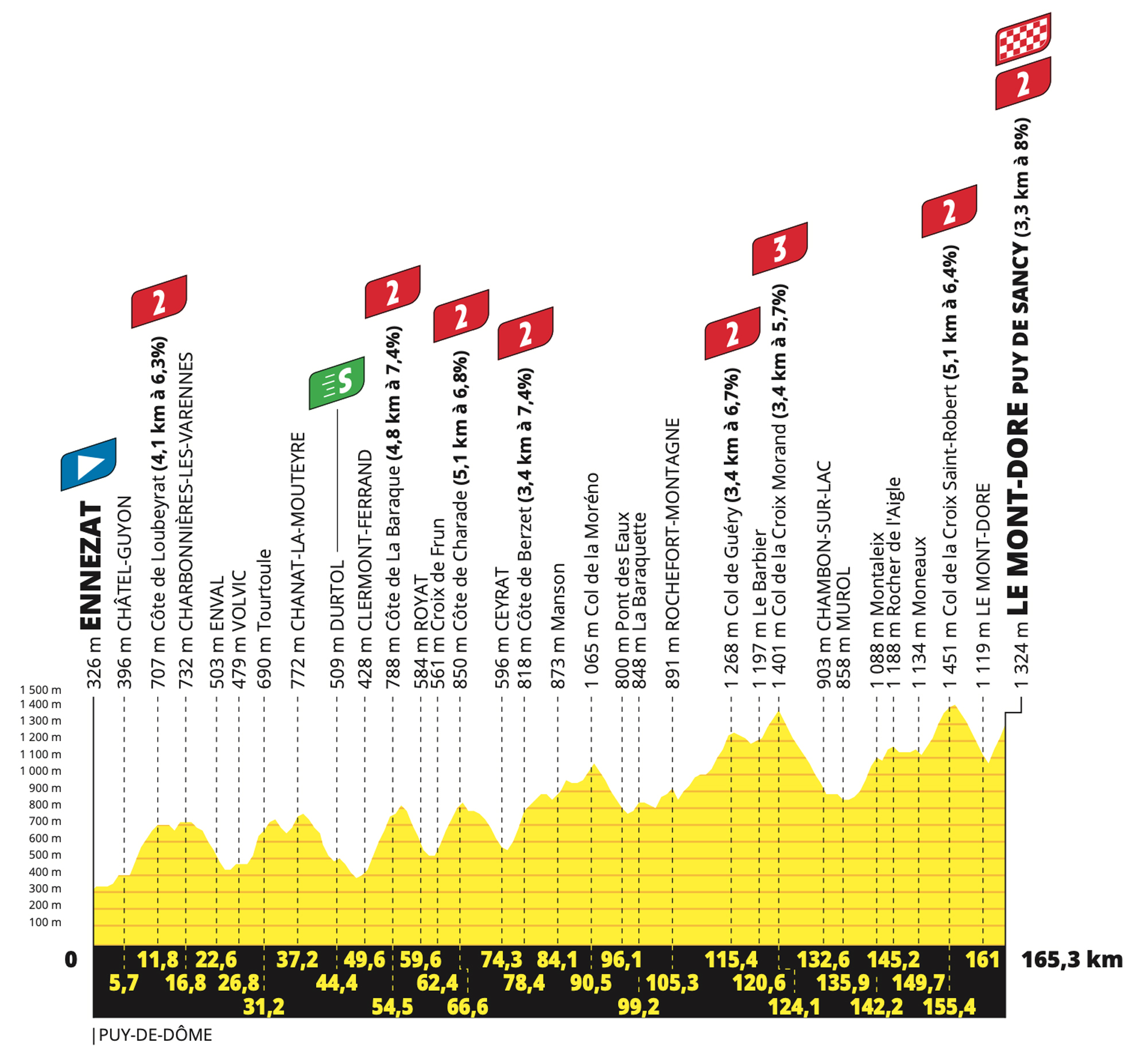
Bastille day and with 4,550m of vertical gain, this is a day for the breakaway and one with traps for the overall contenders too, all on lumpy roads with few portions of flat before the mini ski-station summit finish.
Stage 11 – Wednesday 16 July
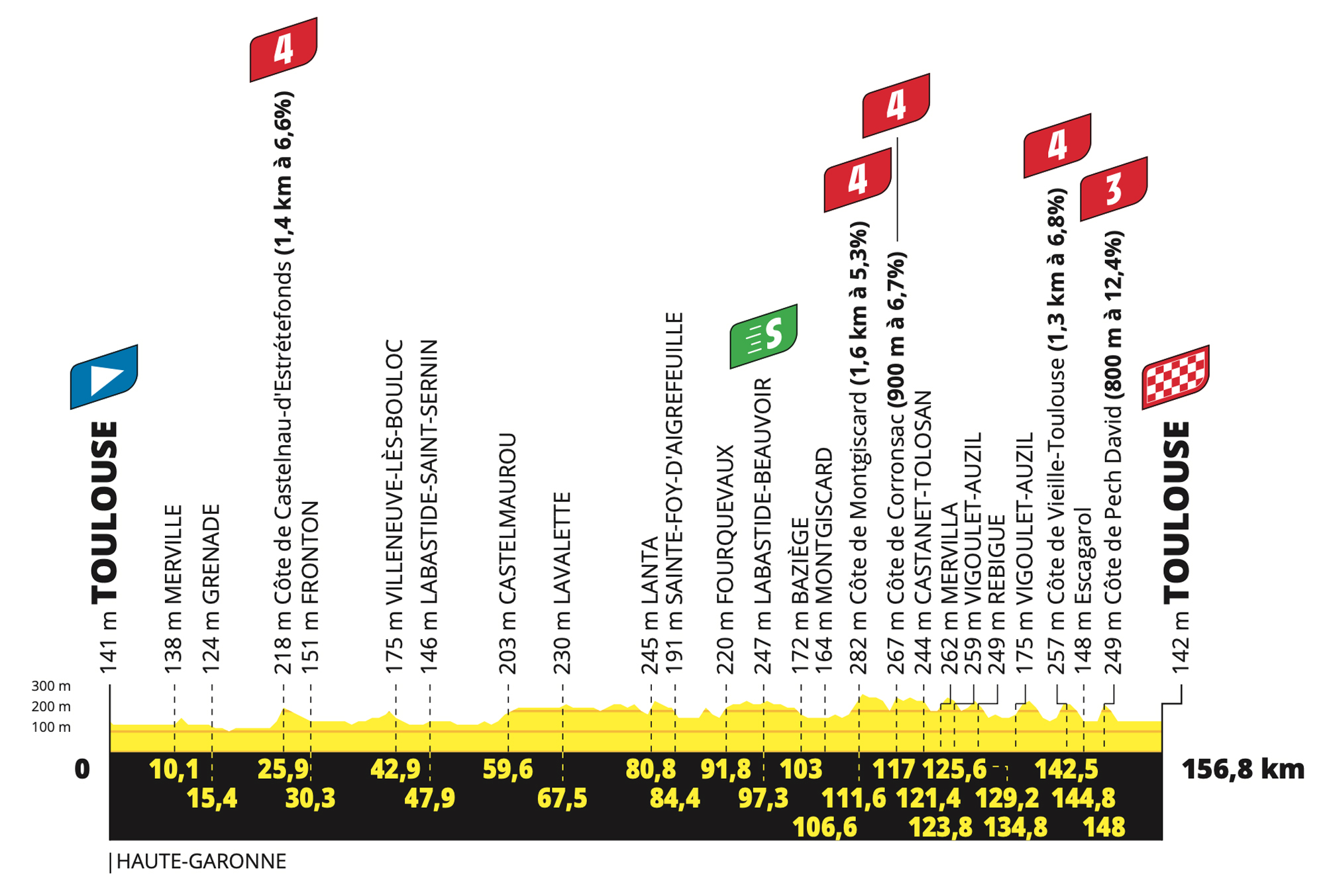
A fun day that heads for the Fronton vineyards and then gets harder, it’s packed with wall-like climbs in the finish with the tricky Pech David climb as the last one. At the least these will thin the field of sprinters, and offer rewards for attackers.
Stage 12 – Thursday 17 July
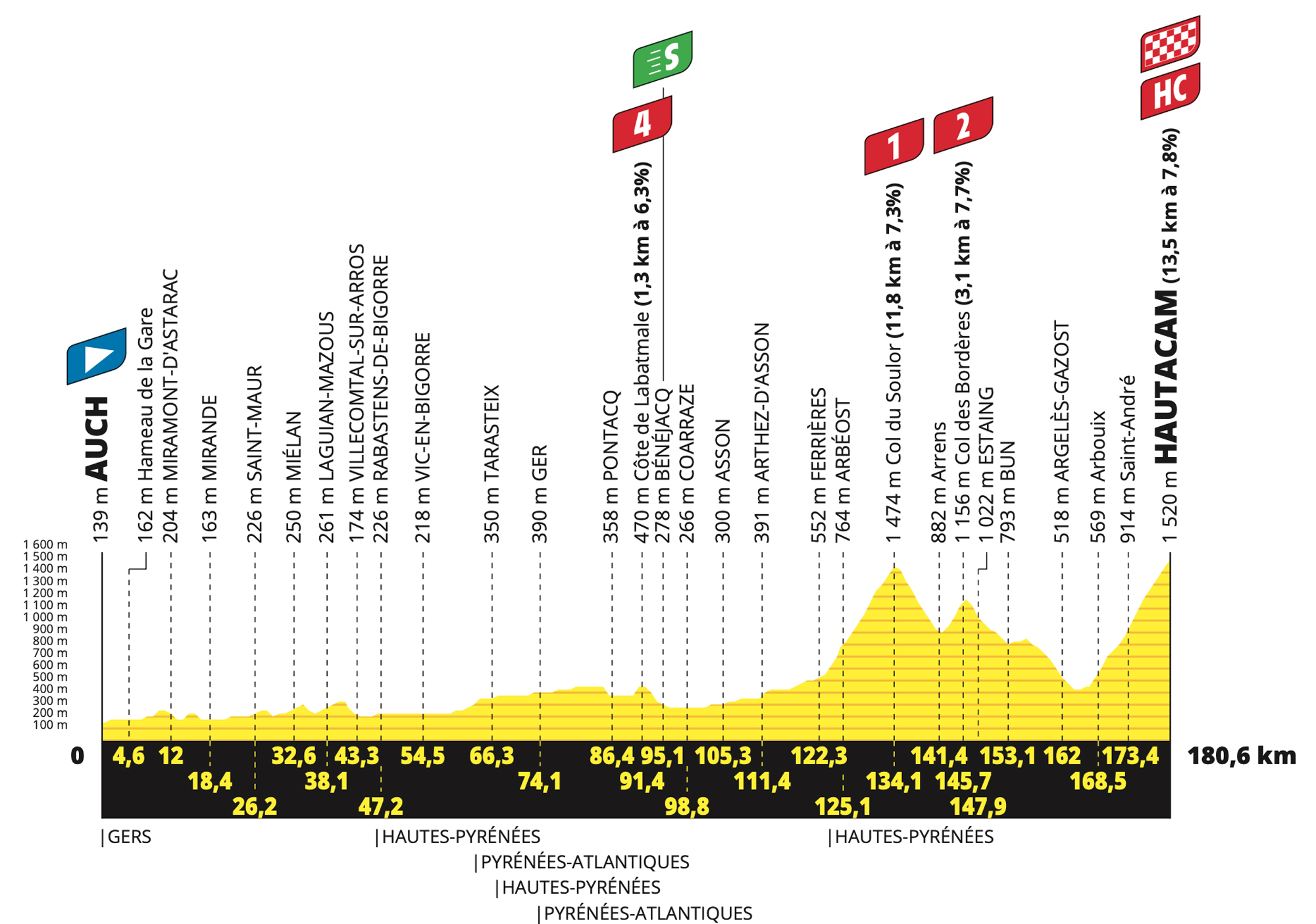
The first big summit finish. A classic as the race takes the valley approach to the Col du Soulor. Then Hautacam where Jonas Vingegaard sealed his Tour de France win in 2023. It’s a long climb with a deceivingly gentle start before a biting middle section.
Stage 13 – Friday 18 July
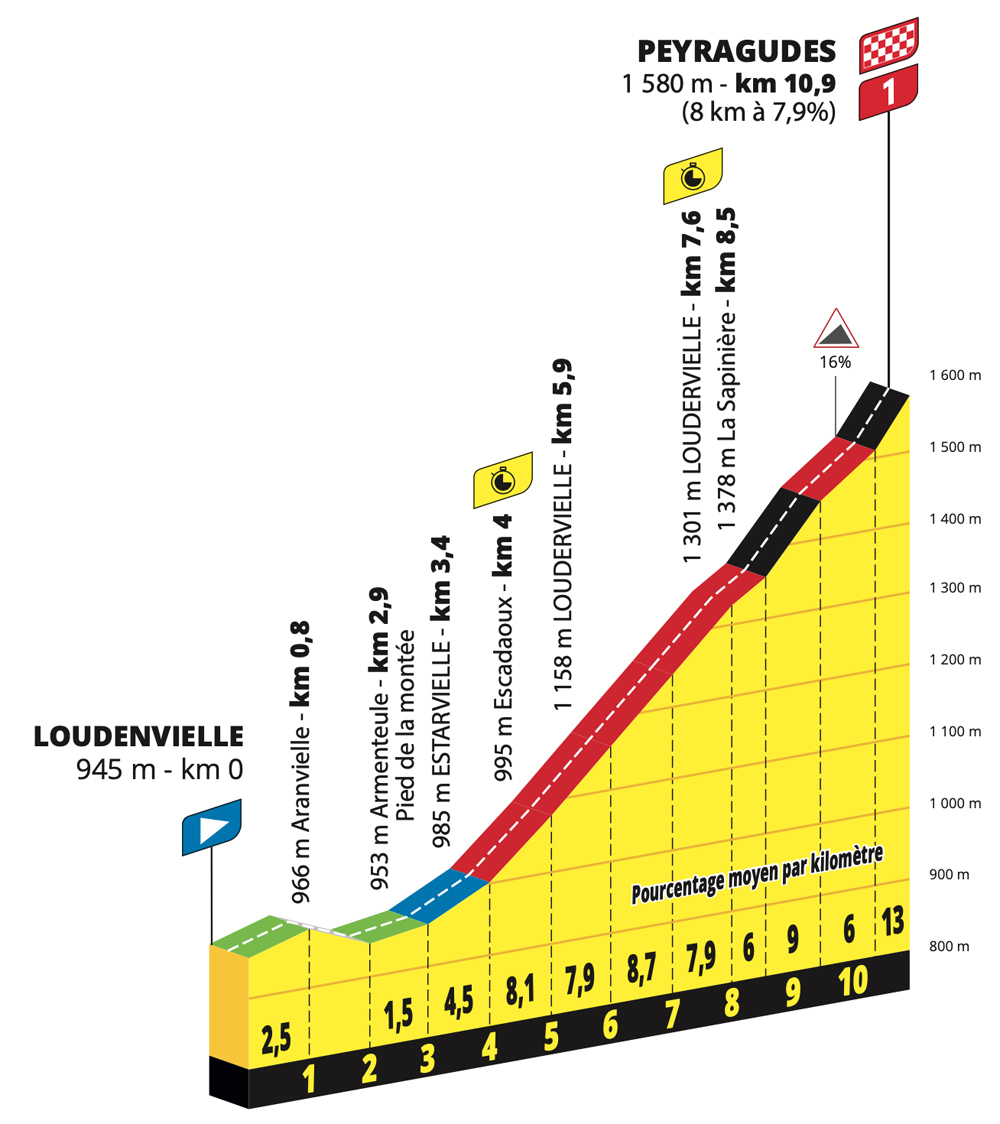
An uphill time trial. There’s a short passage on the flat and then a sharp climb before it’s over to the start of the Col de Peyresourde, enough to have teams thinking about whether to start on a TT bike and change. Normally the Tour de France time cut for time trials is 25% but to the relief of some it is 33% here.
Stage 14 – Saturday 19 July
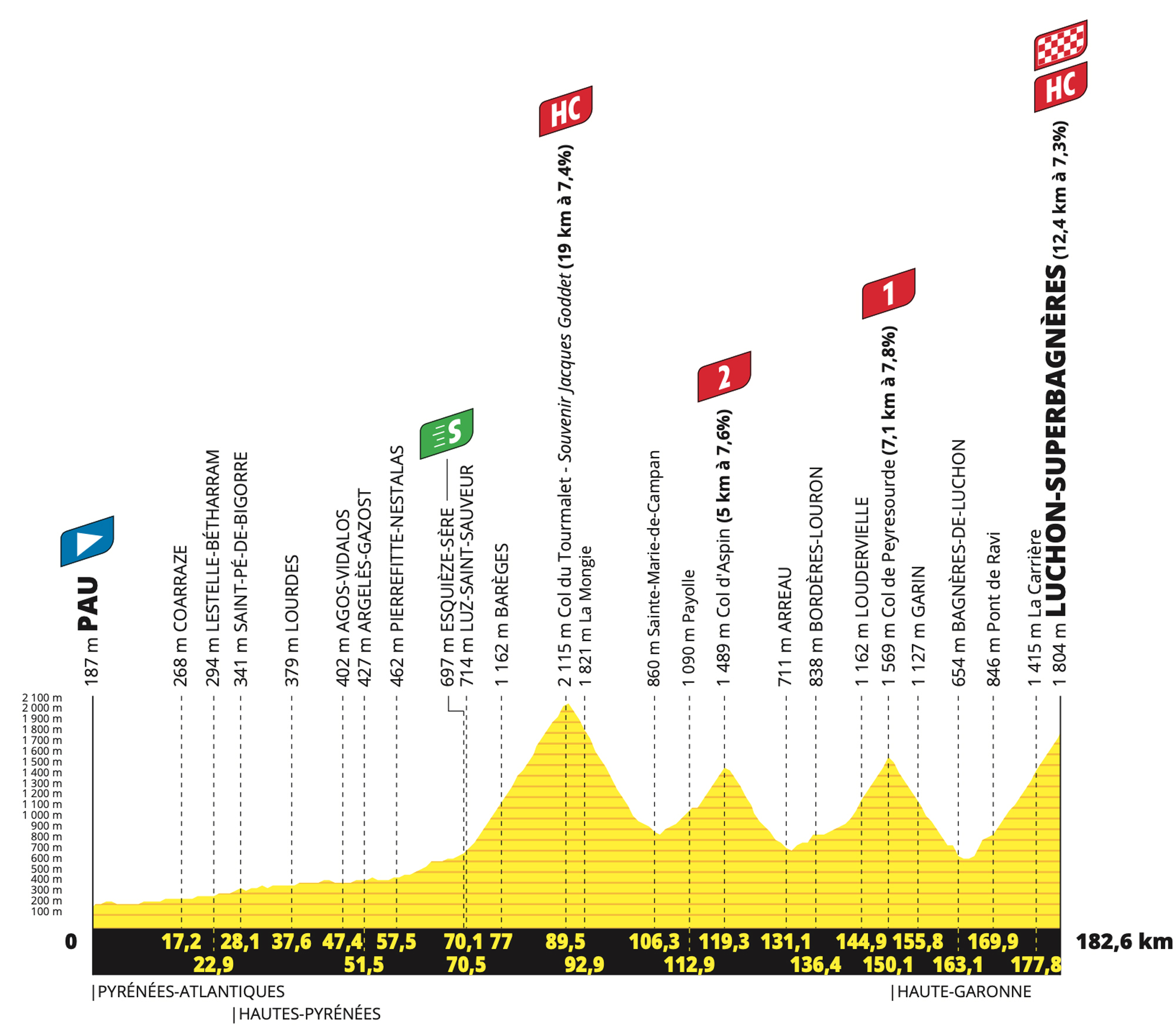
A traditional day in the Pyrenees, it feels like going to an old restaurant and having the same comforting dishes each time with the Tourmalet, Aspin, and then Peyresourde which has already featured the day before. The twist is the return to Superbagnères, not on the menu since 1989 when Laurent Fignon gained twelve seconds on Greg LeMond to take the yellow jersey by seven seconds, a tight scenario to yearn for. The long absence has been logistical, the Pique river had rickety bridges unsuitable for the Tour’s gigantisme and and new bridges have been installed.
Stage 15 – Sunday 20 July
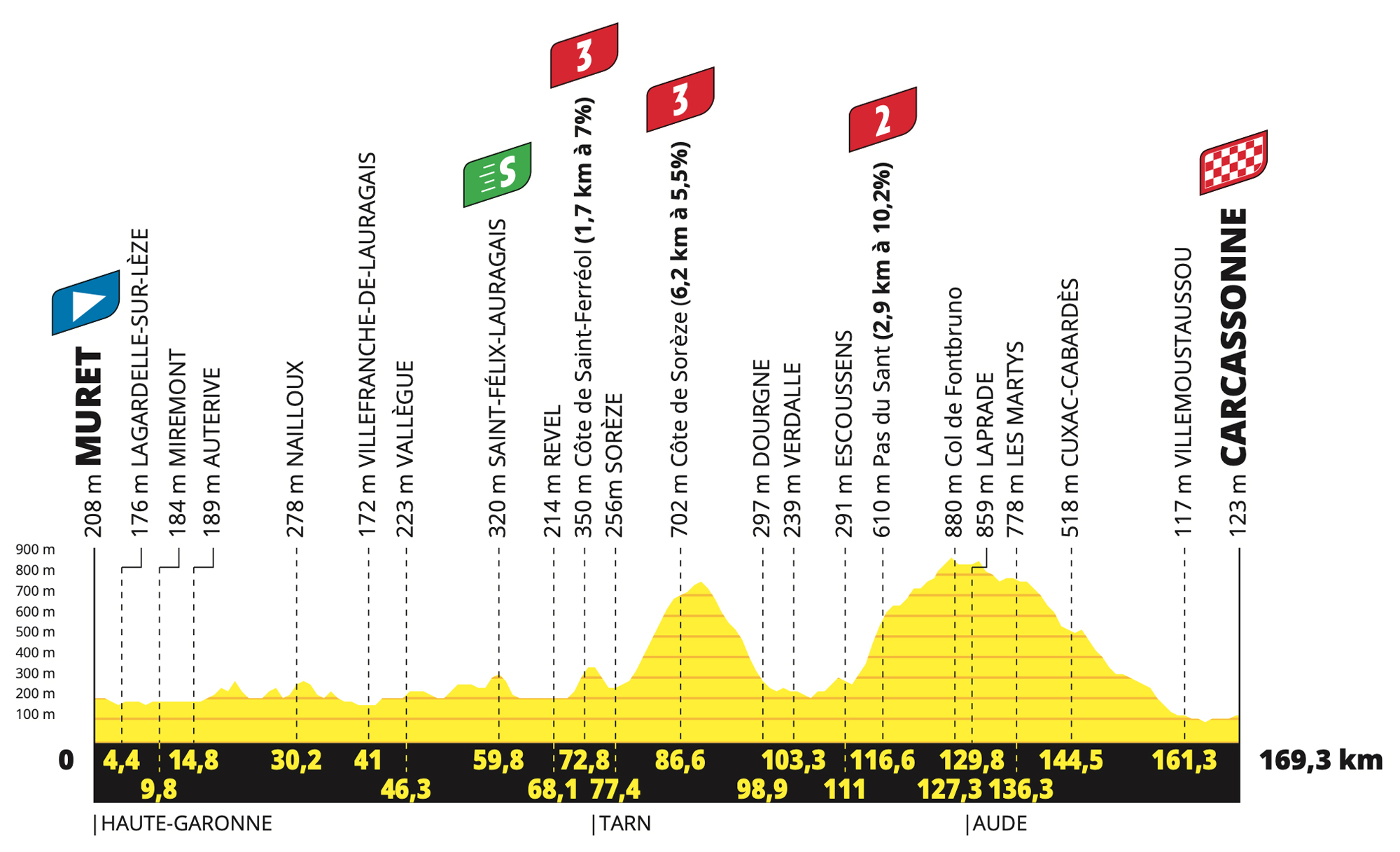
The race leaves Muret for Carcassone via the Montagne Noire mini-mountain range, including the tricky Pas du Sant pass. It should be a battle between the breakaway and the sprinters, with obligatory references to the Vent d’Autan and Tramontane winds. Next is the rest day in Montpellier.
Stage 16 – Tuesday 22 July
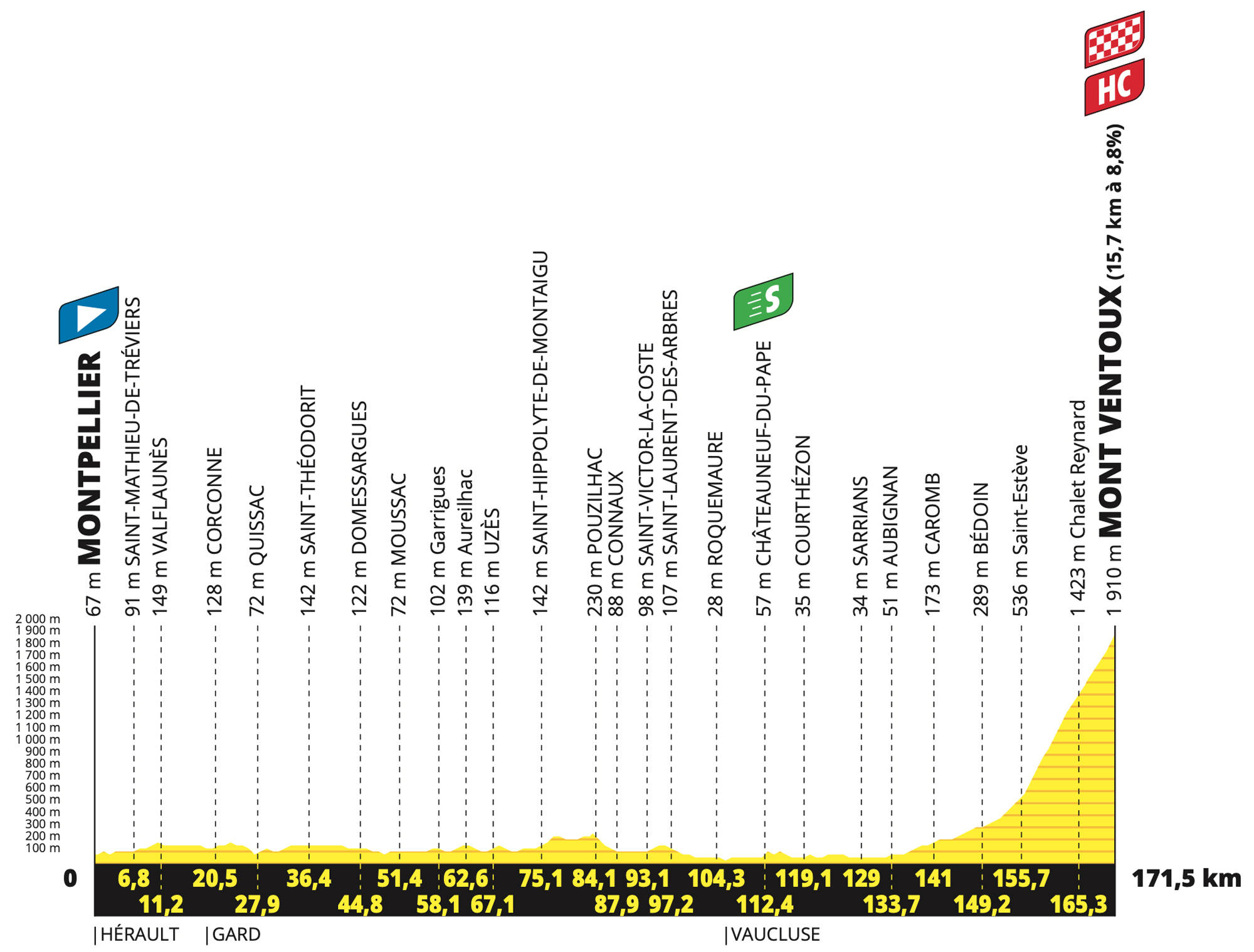
Near flat all day until Bédoin and the classic final 20km up the “Giant of Provence”, the mountain that’s both glorious and also the repository of myths and clichés, a recipe sustained by sparing visits. The last summit finish here was 2013 because if Mont Ventoux featured in 2021 the finish was below in Malaucène; the last summit finish was supposed to be in 2016 but famously the race didn’t make it to the top that day as Chris Froome ran part of the way to Chalet Reynard.
Stage 17 – Wednesday 23 July
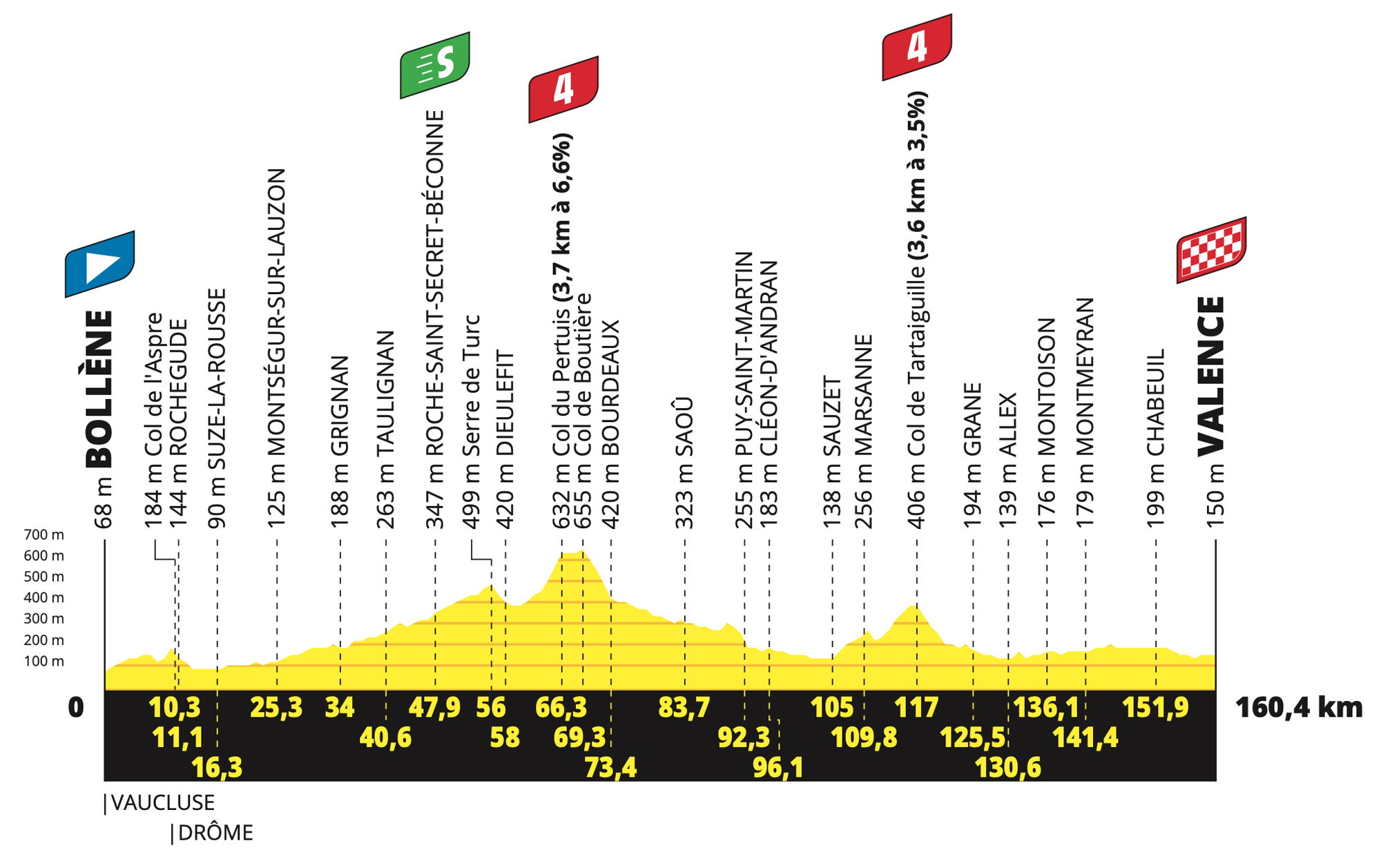
A probable sprint stage, indeed possibly the last chance given the hilly finish in Paris ahead.
Stage 18 – Thursday 24 July

A départ Vif, near Grenoble. It’s the start of a giant day in the mountains with a y-axis of evil totalling 5,500 metres of vertical gain, all in just 171km. The final climb is the Col de la Loze and the novelty is the eastern ascent via Courchevel rather than Méribel like before. It’s not as demented as the western version but still 2,300m high and the final is up a steep cycle path.
Stage 19 – Friday 25 July

More roller coaster racing. The opening climb sees the race avoid the often closed-because-of-landslides main road and the route above Ugine is far harder than the profile suggests. The Saisies takes the race over the Beaufortain part of the Alps and then comes the picture-postcard perfect climb of the Col du Pré which leads to the Cormet de Roselend. The finish is less scenic, the climb to La Plagne has no surprises, the defining feature is the length, almost 20km.
Stage 20 – Saturday 26 July

2,850m of vertical gain across the Jura mountains and by now many teams will be desperate for a summer-saving result which should mean action from start to finish. It’s via the long but gradual Col de la Croix de Serra, later the small but sharp climb in Thésy which featured in the 2023 Dauphiné before some more climbs, some marked and some not, before the road flattens out for the finish.
Stage 21 – Sunday 27 July
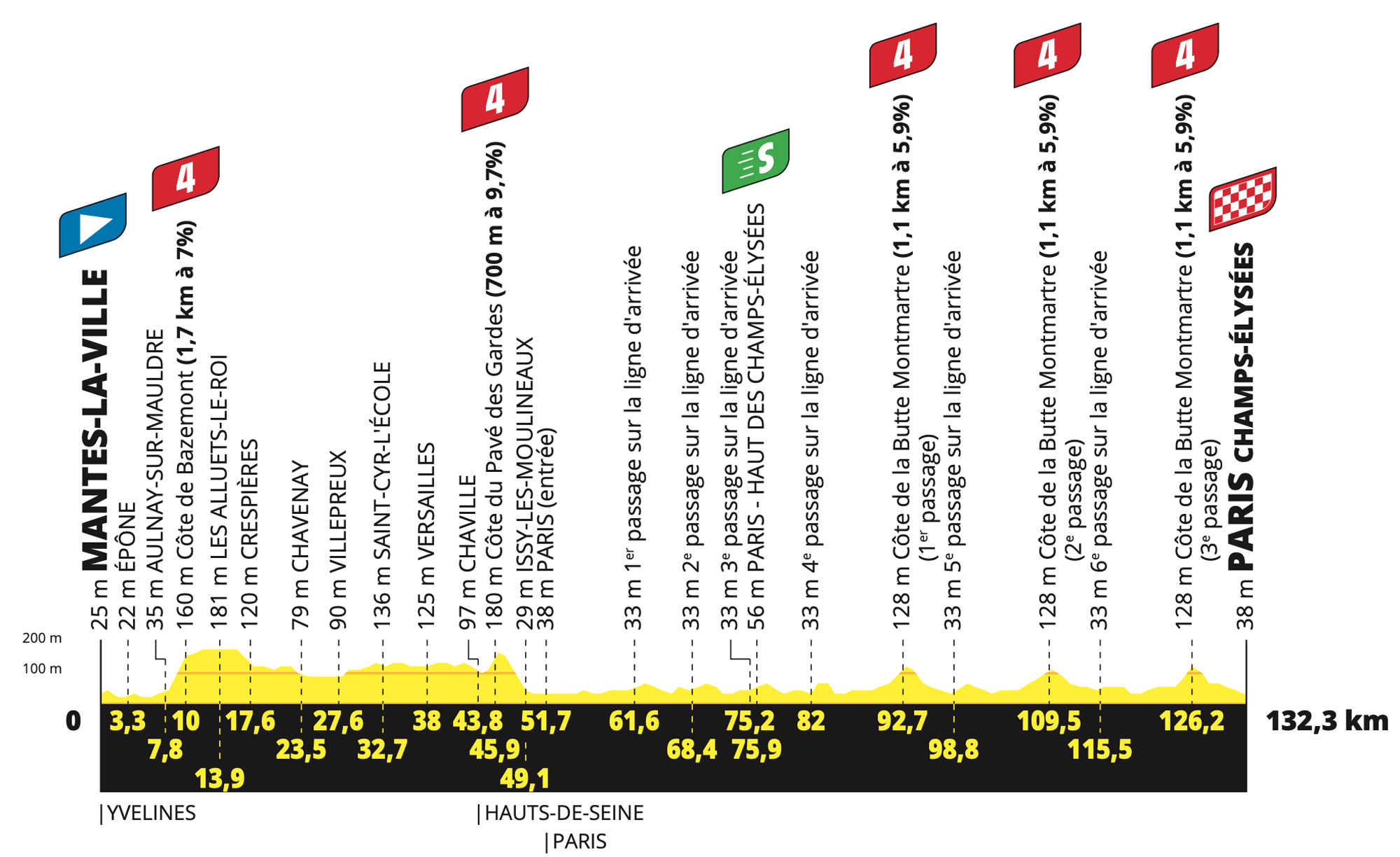
Paris with a twist. We’ll get the champagne photo op parade at the start but once in the city the new climb of Montmartre features. It was exciting in the Olympics because it was the decisive point on the course, here it’ll be interesting to see out it plays out and that’s part of the charm because there’s a blank canvas here rather than a rigid scenario.
The Rules
The Jerseys

Yellow: the most famous one, the maillot jaune, it is awarded to the rider with the shortest overall time for all the stages added together, the rider who has covered the course faster than anyone else. First awarded in 1919, it is yellow because the race was organised by the newspaper L’Auto which was printed on yellow paper. Today it is sponsored by LCL, a bank.
There are time bonuses of 10-6-4 seconds for the finish of each stage except the time trials.
Green: the points jersey, which tends to reward the sprinters. Points are awarded at the finish line and at one intermediate point in the stage and the rider with the most points wears the jersey. It is sponsored by Skoda, a car manufacturer.
- Flat stages (Stages 1,2,3,4,7,8,9,11,15,17,21) 50-30-20-18-16-14-12-10-8-7-6-5-4-3 and 2 points for the first 15 riders
- Hilly finish / Medium mountain stages (Stages 6,16,20): 30-25-22-19-17-15-13-11-9-7-6- 5-4-3-2 points
- Mountain Stages + individual TT (Stages 5,10,12,13,14,18,19) : 20-17-15-13-11- 10-9-8-7-6-5-4-3-2-1 points
- Intermediate sprints: 20-17-15-13-11-10-9-8-7-6-5-4-3-2-1 points
Polka dot: also known as the “King of the Mountains” jersey, points are awarded at the top of categorised climbs and mountain passes, with these graded from the easier 4th category to the hors catégorie climbs which are so hard they are off the scale. In reality these gradings are subjective. Again the rider with the most points wears the jersey. It is sponsored by Leclerc, a supermarket.
- Col de la Loze: 40-30-24-20-16-12-8-4 points
- Hors Catégorie (8 in total): 20-15-12-10-8-6-4-2 points
- Category 1 climbs (5): 10-8-6-4-2-1 points
- Category 2 (12) 5-3-2-1 points
- Category 3 (16): 2-1 points
- Category 4 (26): 1 point
White: for the best young rider, this is awarded on the same basis as the yellow jersey, except the rider must be born after 1 January 2000, ie aged 25 or under. It is sponsored by Krys, a retail chain of opticians
Timekeeping
Three second rule: normally a one second gap on the finish line is needed to separate groups in a finish but for Stages 1,3,8,9,15,17 and 21 are the likely sprint stages, three seconds is needed for a split in the field.
Sprint zone
The three kilometre rule doesn’t apply on Stages 2,6,7,10,12,14,18,19. It’ll be extended to 4km to go on Stage 15, and 5km to go for Stages 1,3,8,9,17 and 21 and this protected part of the course is now being branded as the “sprint zone”.
Time Cuts
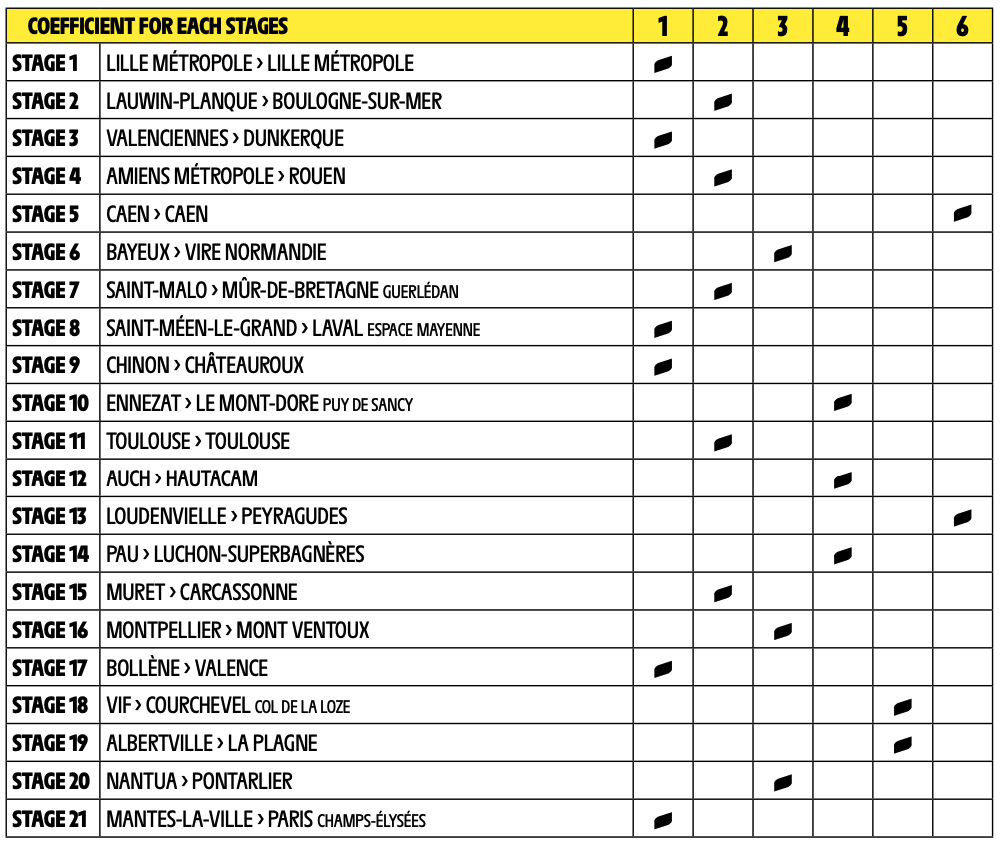
Stages are given a coefficient rating from 1-6, look up the stage’s rating in the table above. Then see the average speed for the day’s winner and look up the corresponding line below to calculate the time cut. Note they’ve been eased by a percentage point this year.
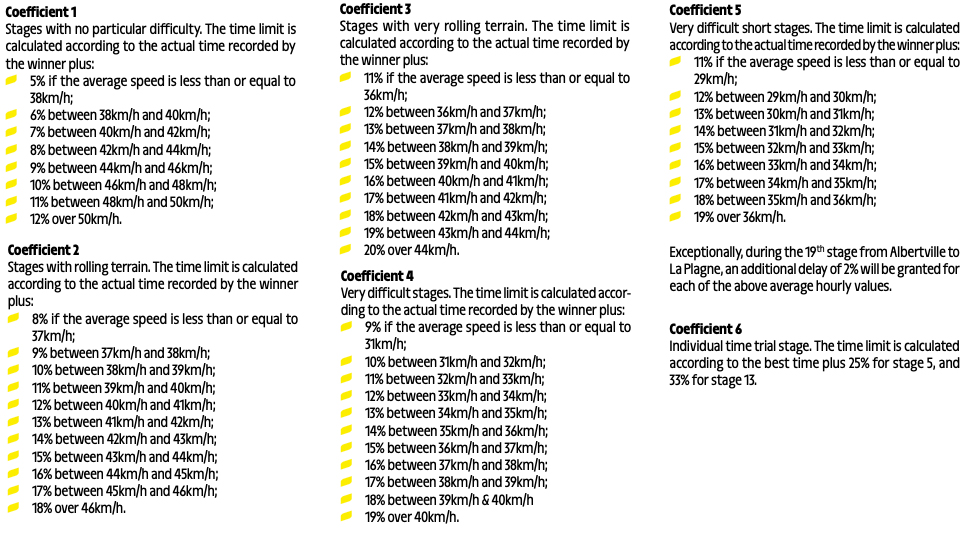
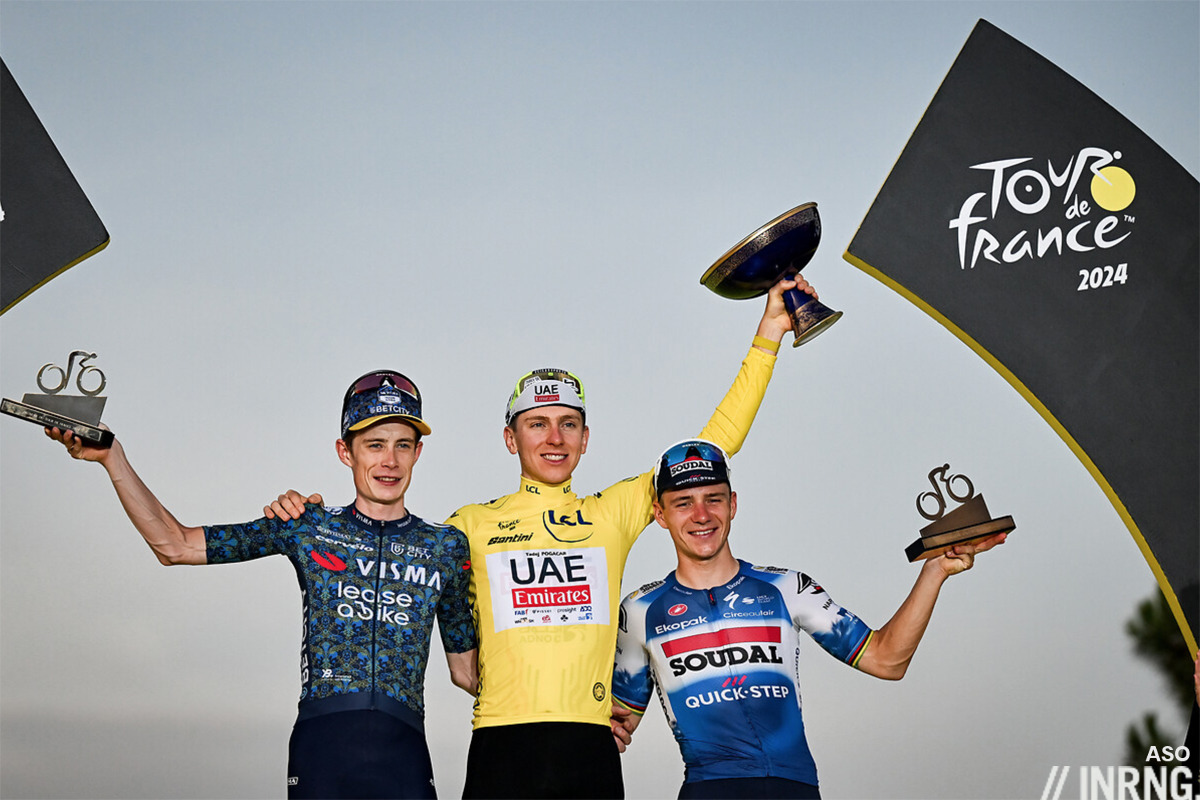
The Prizes
- Each day on a normal stage there’s €11,000 for the winner, €5,500 for second place and a decreasing scale down to a modest €300 for 20th place
- For the final overall classification in Paris, first place brings in €500,000 and the Sèvres porcelain “omnisports trophy”, awarded “in the name of the Presidency of the French Republic”. The full breakdown is €500,000 for first place, €200,000 for second place, €100,000 for third place and then €70,000, €50,000, €23,000, €11,500, €7,600, €4,500, €3,800, €3,000, €2,700, €2,500, €2,100, €2,000 €1,500, €1,300, €1,200 and €1,100 for 19th place. €1,000 for 20th-160th overall
There are other pots of money available in the race:
- €500 a day to whoever wears the yellow jersey
- €300 for the other jersey holders
- €25,000 for the final winner of the green and polka dot jerseys, €15,000 for second place, €10,000 for third place, €4,000, €3,500, €2,500, and €2,000 for eighth in the competition
- €20,000 for the final winner of the white jersey
- There’s also money for the first three in the intermediate sprint each day: €1,500, €1000 and €500
- The climbs have cash too with the first three over an hors catégorie climb earning €800, €450 and €300 and lesser sums for lesser climbs down to €200 for winning a 4th category climb
- The highest point in the race sees a prize when on Stage 18 the Henri Desgrange prize is awarded at the Col de la Loze and is worth €5,000
- the Jacques Goddet prize is also €5,000 for the first over the Tourmalet on Stage 14
- The “most combative” prize is awarded and worth €2,000 each day, the “Super combative” prize is awarded in Paris and the winner collects €20,000
- the best team mate gets €9,000
- to celebrate the 50th anniversary of the polka-dot jersey the first rider to get 50 points wins €5,000
- There’s also a team prize with €2,800 awarded each day to the leading team on the overall, €50,000 for the final winners in Paris with a scale down to €8,000 for fifth place. Note the team prize is calculated by adding the time of the best three riders each day rather than the best three on GC. For example if a team has riders A, B and C make the winning break one day then their times for the stage are taken and added together. If riders X, Y and Z on the same team go up the road the next day, their times are taken. So it’s the times of a team’s best three riders each day as opposed to the best three riders overall.
The total prize pot is €2,577,731. This is meagre for an event of this scale but this isn’t tennis or golf, remember pro cyclists are salaried and paid bonuses by their teams, it’d be hard to find anyone at the Tour on less than a six-figure salary. So prize money is just a nice bonus on the side. Win a Tour stage and a rider might add a zero onto the salary: the race creates value rather than pays it.
Crucially prize money is shared around the team (as well as levied and taxed) rather than pocketed by the winner, it’s possible the actual prize winner sees 5-10% of the headline sum. In addition, every team that starts gets paid a participation fee of over €50,000 to cover expenses. And should a squad make it to Paris with six or more riders they stand to collect an additional €1,600 bonus for each rider.

Thanks for all your work on this! Can’t wait
Personally I think a weekend of sprint stages should be banned — the only days i can watch from start to finish 🙁
Great to see Superbagnères back — I still remember Robert Millar winning there in 89. I think it’s my favourite to ride up and down
2 sprint stages on a weekend is sacrilege. Let’s pray for some wind. Great to see Superbagneres back. Getting a bit tired of Mur de Bretagne now. Stage 20 is interesting, we might actually see some proper racing.
Brilliant work as usual mr Inrng!
I never understood the reasoning behind the sprint stages in the weekends – those days should be the most unpredictable where breaks and/or GC fights can play out. Those are the days where it makes sense to watch an entire stage. Who will watch a sprint stage from start to end? Is that the right way to sell cycling?
Bastille day will likely be deciding. If Pog wins there, the rest of the Tour will likely be irrelevant.
I gather ASO isn’t happy about it either but it’s just timing weekend with the race going to Brittany and then the only way out is flat terrain; they could have moved the time trial but then this would not be a thrill either and adds variety to the week. A gravel stage by the Loire might have been an option but while Paris-Tours is fun, the nature of the gravel with a lot of flint soils means it’s very puncture prone.
The solution is to take the week off as the mid-week days look good 😉
I am surprised they didn’t consider a lumpy stage in Brittany on the Saturday: sonething suitable for the puncheurs with a lot of short-sharp hills, with potential for small splits in the peloton. I guess it might have meant a bigger transfer than they already do.
I was thinking something similar – if the route is the vision of the designer, this seems to be a real failure, especially as so little of the first week looks interesting. I’m hopefully wrong, but it’s possible that the TT will be the only truly selective (for GC) stage in the first 9 days.
Imagine there are multiple constraints, but a redesigned stages 8 and 9 could provide a sprint on stage 8 that finishes further south (perhaps making a longer stage to at least sap the legs), and then a stage 9 that instead has some similar territory to stage 10, which looks really promising.
The first week should be better than you think, there’s terrain to exploit here. Although if the GC riders don’t and others do that should be as good too.
The Paris finish?! How had I missed this…?! No laps of the Champs?
Either way, I’m pleasantly surprised. What are the chances of some CG action on the last day? Could a break win the final stage? I can see a real mix of riders getting in on the action for what will still be a prestige stage and am now looking at travel options…
That Paris finish could indeed become very interesting. At a minimum, it’s a breakaway day. Potentially it’s a GC day, if someone (i.e., Vingegaard) has managed to not ship lots of minutes to Pog in the weeks before, and is still close. Could well be a GC day for the podium, and surely certainly a GC day for the top-10.
Quickly thinking I’m in the minority about wanting stage 21 to keep the traditional sprint.
Have always enjoyed the ‘return of the conquering heroes’ vibe of the parade to Paris, and that the race leader gets his day in the sun. Am content that the GC race is ‘only’ 20 stages
Also, if the stage this year is won by the breakaway / a classics specialist, might we see sprinters climb off at the start of the 3rd week in the future, rather than slogging through the final mountains (excepting anyone in the running for the green jersey)
My first thought whe I read about the change to the final stage was that I’m glad they didn’t do it until after Cavendish retired! I think whether or not I end up enjoying it will depend on the GC standings. If someone has a significant lead then it’ll be fine because they’ll still be able to do the traidtional celebrations before starting racing. However if it’s very tight then I can see it being really awkward because how can the leader celebrate if he could potentially lose the lead later in the stage.
It’s very likely that the one with significant lead is Pogačar, and he will definitely want to race this Montmartre stage.
If it is Jonas, probably will take it easy and as a photo op, but Pogačar will still want to race and so will MvdP, Remco, … it could well end up the best stage of the Tour.
The last point about sprinters climbing off is a good one, and it would be a shame to see this happen – I suppose the organisers need to keep the balance. That said, for all the spectacle of the final sprint, it will be nice to see if this can result in a racing finish. A spectacle all of its own. We could see versatile sprinters, Flanders contenders, and GC riders all trying to get a result.
For now I’m thrilled to see this new look finish, and wouldn’t be disappointed if it rotated each year with the ‘traditional’ lap of the Champs. It’s interesting, also, that as the Giro has moved toward the orthodoxy of a parade-then-sprint for the final stage, the Tour has taken advantage of circumstance and recent history to set itself apart.
I don’t think you are the only one. I too would prefer a parade and a sprint.
I toast stage 6.
The y-axis of evil — brilliant. Though may be lost on many non-US readers.
Chuckled at several of those stage descriptions. Well done and can’t wait!
Would have loved a Tro Bro Leon stage in Bretagne, but I understand the difficulty in throwing a tough gravel stage in the middle of a tour. Overall looks fun
It’s been looked at, especially as it would spice up otherwise flat terrain, so it could well happen when the race returns to Brittany, ie 2027.
In terms of viewing figures on TV, the gravel stage last year did really well. The same happened at the Giro this year, the stage into Siena was great. I anticipate that these types of stages will become more common in the future. For me, I would like one of these stages every year in the tour. They also provide another kind of test for the GC riders, apart from a w/kg test up a mountain, which I think is good.
The dates are wrong from stage 19 on
Stage 18 – Thursday 24 July
then
Stage 19 – Friday 26 July !!
Friday is the 25.06. and last stage is Sunday 27. 😉
Fixed, thanks
Throw in some unseasonably stormy Atlantic weather and the first week could become fun from a GC point of view. The time trial could be interesting too: Pogacar didn’t seem to be drilled in the Dauphine TT and if he finishes down in the standings in the TdF too it might put a bit of self-doubt in his mind*.
*unlikely
If Pogacar’s problem in the time-trial was his position on the TT bike, then this should be fixed quite easily in just a few days.
Stage 10 (after 9 days racing) looks like the, “watch from km 0” stage. Otherwise how fast and furious will the first week be? I’m guessing an average speed about 43 km/h.
The hautacam followed by an uphill TT looks to gift the yellow Jerey to Jonas if he -can do what he did before-
Thanks as always for the great work and looking forward to another set of insightful previews. However, I missed the traditional “they would get too hot” when mentioning the jersey precedence. 😉
Also, on the green points per stage, stage 6 shows twice – I assume the second instance should be stage 5?
Chump change for prize money is a nod to the first origins of the race!
I’m not sure it’s going to be a great race, but this will be my first time at the roadside for a few years so that’s something to look forward to. Starts in the north of the country work well for those of us who can hop across the Channel in an afternoon! And I may get to ride my bike in sunny weather too. Last time I was in Roubaix I almost froze solid.
Interesting course but all those bonus finishes in the first week? I can see Poggie having a 30-45 secs lead going into the first mountain test on stage 12.
Mont Ventoux. A beautiful place and the place to remember the great Tommy Simpson. God rest his soul.
Mister Innrg! Your previews are so appreciated, thank you for your continued insights for this beautiful race. I can’t find the race book for this year’s edition. Have any of you found it?
Superb detailed guide, thanks INRNG